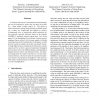Free Online Productivity Tools
i2Speak
i2Symbol
i2OCR
iTex2Img
iWeb2Print
iWeb2Shot
i2Type
iPdf2Split
iPdf2Merge
i2Bopomofo
i2Arabic
i2Style
i2Image
i2PDF
iLatex2Rtf
Sci2ools
ICNP
2005
IEEE
2005
IEEE
The Fundamental Role of Hop Distance in IEEE802.11 Multi-Hop Ad Hoc Networks
In wireless networks, it is well understood what throughput can be achieved by nodes who can hear each other (i.e. nodes within a single cell)[1, 3]. The effects of nodes beyond the sensing range (known as hidden nodes) on a sender are complicated and difficult to analyze. Consequently, how to analytically model multi-hop adhoc networks, specially networks based on the popular IEEE802.11 standards remains largely open. In a recent paper [2], the throughput of a particular wireless network topology (linear network with a given number of hidden nodes) has been derived analytically. In this paper, we unify previous results on single-cell models, and results characterizing different types of hidden node interference and the analysis of [2], to derive a general solution for throughput given a linear network of arbitrary density and transmission distance between source and destination nodes. An important insight from our model is that there is a certain transmission distance, which is less...
| Added | 25 Jun 2010 |
| Updated | 25 Jun 2010 |
| Type | Conference |
| Year | 2005 |
| Where | ICNP |
| Authors | Yan Gao, Dah-Ming Chiu, John C. S. Lui |
Comments (0)

